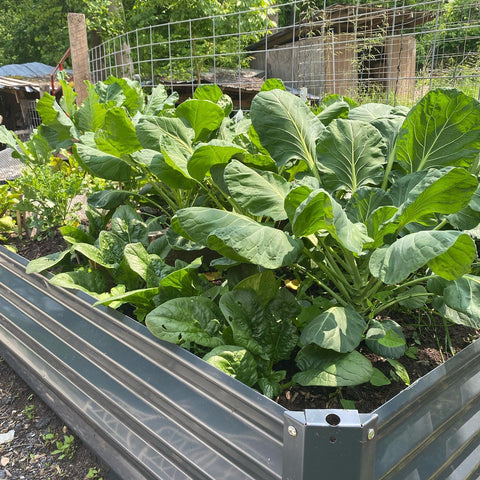In the intricate dance of greenhouse gardening, achieving a balance between nurturing vibrant plants and warding off pesky pests is a delicate art. While chemical interventions are a common solution, a more harmonious approach lies in the embrace of nature's own defenders – plants. In this exploration of "Plants for Natural Pest Control in Greenhouse Gardens," we'll delve into the world of companion planting, highlighting specific plants that act as natural guardians, enhancing your greenhouse's ecosystem and fostering a healthier, more sustainable environment.

Marigolds: The Pest-Repellent Powerhouses
Nematode Deterrence:
Marigolds, with their vibrant golden blooms, are more than just ornamental. These resilient flowers release compounds into the soil that naturally repel nematodes – microscopic pests that can wreak havoc on plant roots. Planting marigolds as a border or interspersed among susceptible plants acts as a natural barrier against these soil-dwelling pests
Aphid Aversion:
Aphids, those tiny sap-sucking insects, find marigolds particularly unappealing. By planting marigolds strategically in your greenhouse, you create a hostile environment for aphids, reducing the need for chemical pesticides.
Basil: A Culinary Herb with Pest-Repellent Properties
Mosquito Control:
Basil, cherished for its culinary uses, has a delightful secret – it repels mosquitoes. While not plant-specific pests, mosquitoes can be unwelcome guests in your greenhouse. Planting basil not only adds aromatic charm but also helps keep these flying nuisances at bay.
Repelling Flies and Mosquitoes:
The pungent aroma of basil extends its pest-repelling prowess to flies and mosquitoes. Placing basil strategically near entry points or among susceptible plants can act as a natural deterrent, reducing the likelihood of infestations.

Chrysanthemums: Nature's Pyrethrum Factory
Pyrethrin Production:
Chrysanthemums are a powerhouse of natural pest control, producing a compound called pyrethrin. Pyrethrin is a potent insecticide that effectively targets a wide range of pests, including aphids, spider mites, and whiteflies. Growing chrysanthemums in your greenhouse provides a continuous supply of this natural defense mechanism.
Whitefly Warfare:
Whiteflies, known for their tiny, destructive nature, are particularly susceptible to pyrethrin. Incorporating chrysanthemums into your greenhouse not only adds a burst of color but also acts as a frontline defense against these persistent pests.
Nasturtiums: A Multi-Faceted Ally in Pest Control
Aphid Magnet:
Nasturtiums have a unique quality – they attract aphids. While this may seem counterintuitive, it serves a strategic purpose. Aphids are drawn to nasturtiums, acting as sacrificial hosts. By luring aphids away from other plants, nasturtiums function as a natural decoy, protecting your more valuable greenhouse residents.
Deterrent for Squash Bugs and Whiteflies:
Nasturtiums also play a role in deterring squash bugs and whiteflies. Their peppery scent acts as a natural repellent, creating an environment that these pests find less inviting. Integrating nasturtiums into your greenhouse layout adds both aesthetic appeal and functional pest management.
Lavender: A Fragrant Shield Against Unwanted Insects
Mosquito and Moth Repellent:
Lavender, celebrated for its soothing fragrance, is also a potent pest repellent. The scent of lavender is known to deter mosquitoes and moths, making it a valuable addition to your greenhouse. Consider planting lavender near entrances or among susceptible plants to create a fragrant shield against flying pests.
Ant Antagonist:
Lavender's aromatic compounds also discourage ants. Ants play a role in protecting and farming pests like aphids, so deterring them helps disrupt this symbiotic relationship. By planting lavender strategically, you create a natural barrier against ant invasions.

Dill: A Beneficial Herb with Pest-Repelling Qualities
Cabbage Worm Deterrent:
Dill, a versatile herb in the kitchen, has an added benefit in the greenhouse. It acts as a deterrent for cabbage worms, which can devastate crops like cabbage, broccoli, and kale. Planting dill among these susceptible plants creates a protective barrier against these voracious pests.
Attracting Beneficial Insects:
Dill also attracts beneficial insects like parasitic wasps and ladybugs. These predatory insects feed on harmful pests, contributing to a natural and balanced ecosystem within your greenhouse.
Rosemary: Fragrant Defense Against Flying Insects
Fly Repellent:
Rosemary, with its fragrant needles, serves as a natural repellent for flies. The aroma of rosemary is displeasing to flies, making it an effective deterrent. Planting rosemary near greenhouse entrances or around susceptible plants helps keep these flying pests at bay.
Companion for Cabbage and Carrots:
Rosemary also serves as a companion plant for cabbage and carrots. Its presence helps deter pests that commonly afflict these crops, contributing to a healthier and more robust harvest.
Conclusion: A Symphony of Natural Harmony in the Greenhouse
As we immerse ourselves in the world of natural pest control in greenhouse gardens, the beauty of this approach becomes evident. Instead of relying on harsh chemicals, we can harness the power of companion plants to create a symphony of natural harmony within the greenhouse. From marigolds standing guard against nematodes to chrysanthemums producing pest-repelling pyrethrin, each plant plays a role in fostering a healthier and more sustainable ecosystem. By embracing the art of companion planting, you not only protect your plants but also contribute to a greener and more harmonious world.









